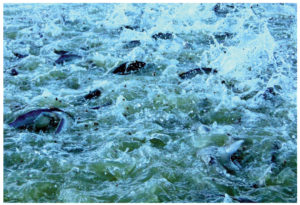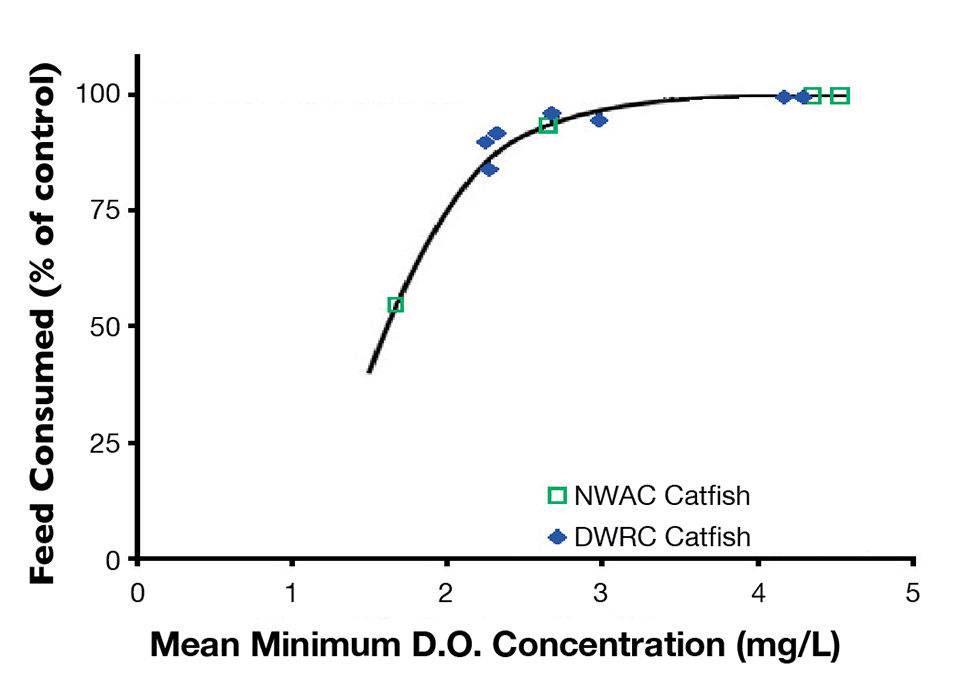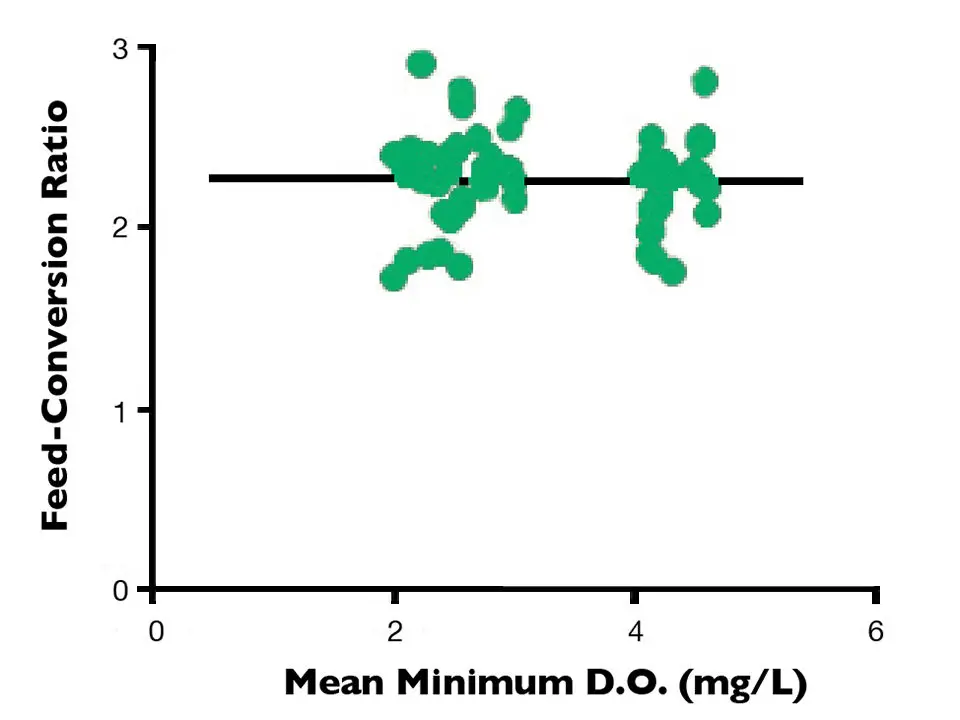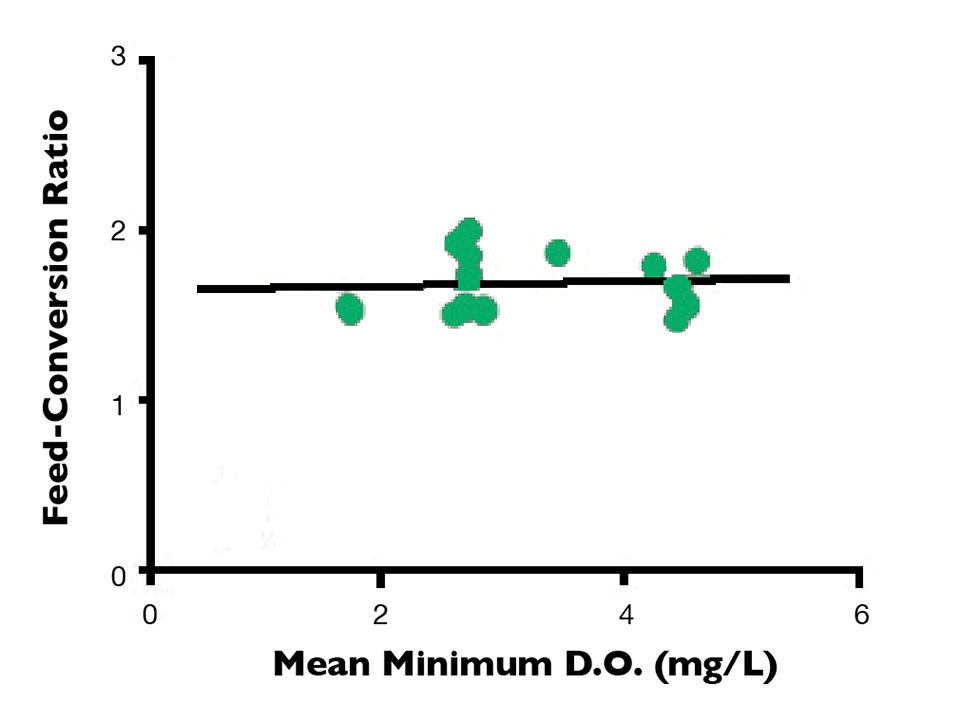Low morning dissolved oxygen concentrations could negatively impact FCR

Since feed represents the single greatest cost in channel catfish production in the United States, the feed-conversion ratio (FCR) is the most common indicator of catfish production efficiency. Feed conversion is affected by many variables in addition to feed quality, including disease losses, bird predation, feeding practices and cropping system.
Many farmers and scientists also believe that feed conversion is affected by the dissolved oxygen (D.O.) concentrations of culture water, but convincing data has been lacking to date. Research by the author examined the impacts of dissolved-oxygen levels on channel catfish feed consumption, growth and FCR.
Mississippi trials
Two facilities were used to conduct the studies – six 0.1-hectare ponds at the Thad Cochran National Warmwater Aquaculture Center (NWAC) in Stoneville, Mississippi, USA, as well as 15, 0.4-ha ponds at the Delta Western Research Center (DWRC) in Indianola, Mississippi.
Fish in all studies were fed to apparent satiation every two to three days in the spring, when water temperatures were low, and once daily after the pond temperatures reached 25 degrees-C. Ponds were harvested in the fall. High aeration capacities of 12.5-15.0 hp/ha were used so desired minimum D.O. concentrations could be maintained through the growing season. The lowest concentrations studied were higher than those at which catfish show a visible stress response.
Effects on growth
The studies consistently demonstrated that until the morning D.O. concentration fell below 3.0 mg/L, feed consumption of channel catfish was not affected (Fig. 1). Feed consumption began to decrease as the D.O. concentration dropped to 2.5 mg/L, and then fell off rapidly at lower oxygen levels. At an average morning D.O. concentration of 1.6 mg/L – the lowest concentration studied – feed consumption was reduced by 45 percent.

Hypoxia has been shown to at least partially limit feed consumption in rainbow trout by increasing the production of corticotrophin-releasing factor and urotensin I, which contribute to stress response and regulate appetite. A similar mechanism has not yet been demonstrated in channel catfish, but is presumed to exist.
Restricted feeding, whether imposed by farm management or as a voluntary fish response to low morning D.O. concentrations, reduces growth rate and can add months or even years to the production cycle. In one study, channel catfish fingerlings averaging 37 grams grew to 0.77 kg in one season when managed with a high morning D.O. concentration, while catfish maintained at 1.6 mg/L ate 45 percent less and grew to only 0.54 kg. The smaller fish would require an additional winter and at least part of another growing season to reach market size.
Slower growth means that more time is needed to produce a food fish, and more time in the pond will result in additional mortality. Overall monthly mortality from all causes in commercial ponds has been estimated at 1 to 2 percent. Thus, every additional year in the production cycle could mean an additional 12 to 24 percent mortality. These fish losses, especially of larger fish that have eaten more feed, can have a major impact on the farm-level FCR. Fish also feed more aggressively with higher morning D.O. concentrations. This makes it easier to feed them without wasting feed.
Effects on FCR
Aside from the effects of low D.O. concentration on feed intake, which affects growth, time to harvest, total mortality and ultimately FCR, can D.O. levels directly impact FCR? The answer from our research is no – and yes.
Channel catfish FCRs from individual ponds in multiple studies at DWRC and NWAC maintained at different morning D.O. concentrations are shown in Figs. 2 and 3. While the FCRs differed slightly between the two facilities, the data indicated that within the D.O. range examined, FCR was not directly affected by morning D.O. concentration. The catfish converted feed to flesh at roughly the same efficiency at D.O. concentrations ranging 1.6-5.0 mg/L.


However, evidence indicated that morning D.O. concentrations lower than those that occurred in the studies could have a direct negative impact on FCR. It is not unusual to see commercial ponds with D.O. concentrations dropping to 1.0 mg/L or even lower. At these extremely low levels, fish are typically seen near the water surface in the aerator outflow, and even bunched up around the ends and inflow side of the aerators.
Feed intake is likely reduced by over 70 percent under these conditions. Nutritional studies have shown that when feed intake is restricted to approximately 1 percent body weight daily for fingerlings and slightly lower for larger fish, FCRs do get higher. This is not due to poor digestion or assimilation of feed, but simply because a larger proportion of feed intake is used for maintenance, and less is available for growth.
Perspectives
In summary, FCRs can be improved through oxygen management in two different ways. Poor FCRs may be due directly to extremely low D.O. concentrations, which can limit feed intake to near-maintenance levels. In those cases, FCRs can be immediately improved by raising the minimum D.O. concentration.
Once morning D.O. concentrations reach 1-2 mg/L, FCRs are not directly improved by further increases in morning D.O., but catfish will consume more feed and grow faster up to a morning concentration of approximately 3 mg/L. This faster growth will result in a shorter two-year production cycle for channel catfish, less overall mortality and improved feed conversion. This may be the best practical method for improving catfish FCRs.
(Editor’s Note: This article was originally published in the January/February 2011 print edition of the Global Aquaculture Advocate.)
Author
-
Les Torrans, Ph.D.
USDA ARS Catfish Genetics Research Unit
Thad Cochran National Warmwater Aquaculture Center
Stoneville, Mississippi 38776 USA
Tagged With
Related Posts

Innovation & Investment
Assessing coloration in channel catfish fillets
Because consumers look at color to gauge quality of catfish fillets, the authors developed a digital photography measurement method to assess yellowness.

Aquafeeds
A look at corn distillers dried grains with solubles
Corn distillers dried grains with solubles are an economical source of energy, protein and digestible phosphorus to reduce feed costs and fishmeal usage.

Health & Welfare
A look at tilapia aquaculture in Ghana
Aquaculture in Ghana has overcome its historic fits and starts and is helping to narrow the gap between domestic seafood production and consumption. Production is based on Nile tilapia.

Intelligence
A motive, and a market, for farmed fish in Mexico
Boasting ample areas for aquaculture and a robust domestic demand for seafood – not to mention its close proximity to the U.S. market – a land of opportunity lies in Mexico. Fish farming is primed to meet its potential south of the border.


